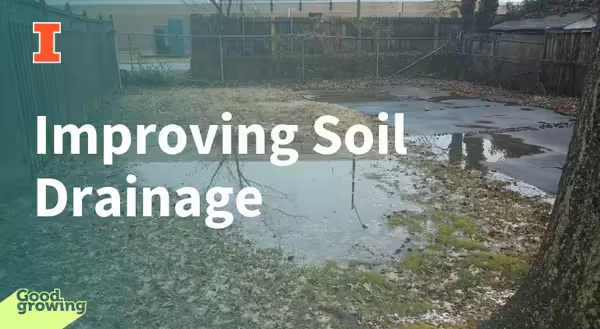
With all the rain we have received this spring, you may have noticed some areas in your lawn or fields where water ponds. The rate at which water moves through the soil profile is influenced by pore size in the soil. When there are issues with poor drainage, soil has smaller pores and holds water for longer periods of time.
Soil Composition
Soil is made up of sand, silt, and clay particles that vary in size; sand being the largest and clay the smallest. Soils that are primarily sand tend to have more pore space and are more quickly drained; while clay soils have less pore space which slows water movement through the soil profile and holds the water for extended periods.
Soil Compaction
Compaction of our soils can occur from something as heavy as equipment during construction or as light as repeated foot traffic (think of the area along sidewalks). Compaction compresses the soil pores and limits oxygen and water space in the soil. Too much tillage or tilling at the wrong time (i.e. when soil is too wet) can also have a negative impact from the formation of hard pans that are impervious to water.
Testing Soil Drainage
If you are unsure if you have issues with soil drainage, a soil percolation test can be done to determine the water absorption rate. To conduct a percolation test, use a hand auger, posthole digger, or shovel to dig a hole at least 12 inches deep and 4 to 12 inches wide. Perk tests should not be done when the soil is overly wet as it can give false test results.
Once the hole is dug, fill it with water and let it drain completely; this could take anywhere from a short period of time to an entire day. By doing this, it saturates the soil. Immediately after the water has drained, refill the hole with water and measure the depth of the water with a ruler. After 15 minutes, measure the drop in water in inches; multiple this number by 4 to calculate how much water drains in an hour. A rate of 1 to 3 inches per hour is considered desirable for most plants. Soils that drain less than one inch per hour are considered to have poor drainage.
Improving Drainage
Soils with poor drainage can be improved by incorporating organic matter such as compost. Incorporating organic matter into poorly drained soil improves nutrient, water, and air holding capacity. Organic matter also improves soil structure by increasing soil aggregation which is the binding of soil particles together. The use of cover crops can also introduce organic matter to soil especially in areas such as annual flower beds or vegetable gardens.
Other ideas to reduce compaction include avoid driving, walking, or working wet soils. Tillage or aeration can be used to break up hardpans or impermeable layers. Raised beds can provide an alternative option for growing vegetables, annual, or perennial plants.
Good Growing Tip: When it comes to planting in areas of poor drainage, different plant species will tolerate wet conditions better than others, so be aware of this before planting.